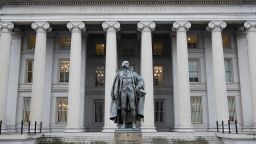Most Federal Reserve officials said last month that they expect one more rate hike, according to minutes from their September policy meeting released Wednesday. Some officials said that how fast inflation cools in the coming months will determine how long rates remain elevated.
“A majority of participants judged that one more increase in the target federal funds rate at a future meeting would likely be appropriate, while some judged it likely that no further increases would be warranted,” the minutes said.
The Fed held its key lending rate steady at a 22-year high in September as the central bank aims to assess more economic data to understand how the US economy is responding to previous rate hikes. Inflation’s steady descent over the past year, and the job market’s gradual cooldown, gave officials enough reassurance to pause, the minutes showed.
There is lingering uncertainty over how much the Fed’s 11 rate hikes since March 2022 will weigh on economic activity. Financial markets are pricing in another pause at the Fed’s upcoming October 31-November 1 monetary policy meeting, so that hike could come in December, depending on what economic figures reveal in the coming months.
The central bank’s latest set of economic projections also showed that most Fed officials expect fewer rate cuts next year, confirming investors’ fears that rates could remain higher for longer. Some officials said last month that how long they remain elevated hinges on inflation’s trajectory.
“A few participants noted that the pace at which inflation was returning to the committee’s 2% goal would influence their views of the sufficiently restrictive level of the policy rate and how long to keep policy restrictive,” according to the minutes.
Bond market moves
The expectation that rates will remain elevated for longer thrust the bond market back into the doldrums, driving US Treasury yields higher and inflicting pain on investors who expected rate cuts sometime this year. The bond market’s selloff increases the financial burden for American families and businesses, since US Treasuries are the benchmark used to price debt. That means higher yields lead to higher rates on everything from car loans to the cost of mergers and acquisitions.
Fed Chair Jerome Powell has said the central bank needs to see “below-trend growth” to be assured that inflation is on track to the Fed’s 2% inflation target. It’s unclear how much higher yields will weigh on economic activity, but several Fed officials have said in public remarks this week that it could mean less action from the Fed.
Fed Vice Chair Philip Jefferson, the number two official at the US central bank, said Monday that he would “remain cognizant of the tightening in financial conditions through higher bond yields and will keep that in mind as I assess the future path of policy.” Dallas Fed President Lorie Logan expressed a similar sentiment this week.
Wednesday’s minutes noted that “tighter credit conditions facing households and businesses were a source of headwinds for the economy and would likely weigh on economic activity, hiring, and inflation.”
If both economic growth and job market continue to cool, then the Fed might not go forward with another hike.
Employers added a robust 336,000 jobs in September as the unemployment rate held steady at low 3.8%, and some volatility in energy markets pushed up gas prices, leading to a pickup in headline inflation in August, though gas prices have retreated in recent days. The Labor Department releases its Consumer Price Index for September on Thursday.
Balancing upside and downside risks
The Fed is at a point where its decisions could either inflict too much economic pain or not do enough to tamp down inflation. That means Fed officials have to be highly attuned to downside and upside risks to both inflation and economic activity if the central bank wants to defeat inflation without a sharp rise in unemployment.
“All participants agreed that the Committee was in a position to proceed carefully and that policy decisions at every meeting would continue to be based on the totality of incoming information and its implications for the economic outlook as well as the balance of risks,” the minutes said.
Fed officials noted that the ongoing United Auto Workers strike was “a new source of uncertainty” and that “an intensification of the strike posed both an upside risk to inflation and a downside risk to activity.”
The UAW union said this week that nearly 4,000 members walked off the job at heavy truck manufacturer Mack Trucks after voting down a tentative agreement. Officials also pointed to the risk of volatile energy markets that “could undo some of the recent disinflation.”
The minutes also pointed to the possibility of credit conditions becoming even tighter “if the domestic banking sector experienced further strains.”
On top of a mountain of risks to the outlook for the economy and inflation, Fed officials also discussed last month how government data might be making it hard to paint a clear picture of the economy.
“A few participants observed that there were challenges in assessing the state of the economy because some data continued to be volatile and subject to large revisions,” the minutes said.











